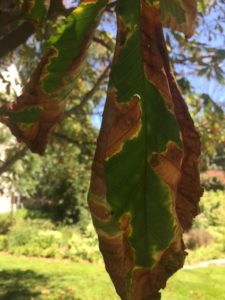Horse Chestnut Leaf Blotch, also referred to as Guignardia Leaf Blotch, is a common fungal disease throughout the DC Metro Area. While non-native, the Horse chestnut is widely planted in urban and suburban landscapes.
Like most fungal diseases, these pathogens thrive in wet conditions. The rainy year we have been having will most likely lead to not only more horse chestnut leaf blotch infections but also more severe infections.
Susceptible Trees: Like the name implies this fungus mostly targets Horse Chestnut Trees. However, Buckeye trees may also serve as hosts.
Horse Chestnut Leaf Blotch Symptoms:
From a distance, the infected tree will appear to be scorched but close up you will find:
- Reddish-brown spots on leaves often surrounded by yellow halos
- Brown leaves
- Shriveled leaves
If the infection progresses enough you will also encounter early leaf drop in late summer weeks before the typical leaf drop in fall.



Need Help With Horse Chesnut Leaf Blotch/Guignardia Blotch?
Meet With A Certified Arborist
Or Call Us At 703-573-3029
Lifecycle:
Although you may not notice the symptoms of horse chestnut leaf blotch until late summer the infection begins in spring. After the tree blooms in spring infected trees will start to experience pale green lesions that turn orange-brown as they dry. These lesions will distort the trees leaves for the remainder of the growing season. Once winter comes the fungal spores will overwinter in dead leaf debris then become active again in the spring re-infecting the tree.
Leaf Blotch Treatments:
Unfortunately, once infected you will have to live with the unsightly leaf blotch until the leaves drop in fall. However, you can prevent your tree from becoming infected again in the spring.
- Rake. To reduce chances of reinfection next spring rake all leaves and twigs and remove them from the property.
- Prune. Proper pruning can improve air circulation throughout the tree’s canopy speeding up the drying of leaves.
- Fungal Control. A series of fungicide applications in the spring can protect your tree from this fungus.


